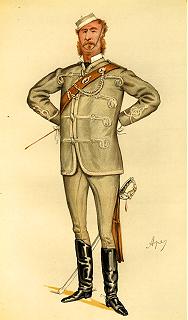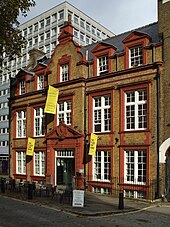| ColonelSir Robert William EdisKBE CB DL JP | |
|---|---|
 "Architecture Militant", caricature of Edis by "Spy" (1885) "Architecture Militant", caricature of Edis by "Spy" (1885) | |
| Born | Robert William Edis (1839-06-13)13 June 1839 Huntingdon |
| Died | 23 June 1927(1927-06-23) (aged 88) |
| Education | Huntingdon Grammar School Aldenham School |
| Spouse | Elizabeth Ann Woodward |
| Children | 5 |
| Relatives | Isabella Reaney (sister) Olive Edis (niece) |
Colonel Sir Robert William Edis KBE CB DL JP (13 June 1839 – 23 June 1927) was a British architect.
Early life
Edis was born in Huntingdon to Emma and Robert Edis, also an architect. His sister was the preacher Isabella Reaney, his brother was Arthur Wellesley Edis, a gynaecologist, and his niece through Arthur was the photographer Olive Edis.
Edis was educated at Huntingdon Grammar School and Aldenham School, before attending University College School in London and studying at the Royal Academy Schools. He was then articled to William Gilbee Habershon and Edward Habershon, architects, in London.
Career

He became chief assistant to Anthony Salvin, and joined the Architectural Association in 1859. He was admitted an Associate of the Royal Institute of British Architects in 1862 and a fellow of the association in 1867.
Although his early work was Gothic, Edis later became a proponent of the Queen Anne style of baroque revival architecture. He worked mostly on private houses and public buildings, although he did design a few churches.
He later became involved in the Aesthetic Movement of decorative arts and in furniture design, and delivered a series of Cantor lectures on the subject at the Royal Society of Arts. These formed the basis of two books: Decoration and Furniture of Town Houses (1881) and Healthy Furniture and Decoration (1884). Combining principles of Aestheticism with the Sanitary Movement, Edis delivered a lecture during the 1884 International Health Exhibition calling for more artistic designs within hygienic interior objects.

From 1883, Edis extended and rebuilt Sandringham House in Norfolk for the Prince of Wales. He was the designer of the parish hall and parsonage for St Philip's Church, Buckingham Palace Road (1892) and the British pavilion at the World's Columbian Exposition in Chicago (1893).
He built a studio on Church Street, Sheringham, for his nieces the photographers Olive and Katharine Edis. It was their first studio and had a glass roof to allow in natural daylight which became an important aspect of their trademark style.
Edis had a long association with the Volunteer Force and its successor the Territorial Force. In 1868 he received a commission in the Artists' Rifles. He went on to be the regiment's commanding officer from 1883 to November 1902, and subsequently held the office of honorary colonel from 1902 until his death (he continued when the regiment was reorganized as part of the Territorial Force in 1908). He designed the unit's drill hall at Duke's Road, off Euston Road, Camden (now The Place, home of the Contemporary Dance Trust).
In January 1889 he was elected a member of the first London County Council, representing St Pancras South for three years as a member of the Conservative-backed Moderate Party.
Personal life
In 1863, Edis married Elizabeth Ann Woodward. He had homes at Ormesby Old Hall, Great Ormesby, Norfolk, as well as Fitzroy Square and Regent's Park, London. He was a justice of the peace and a Deputy Lieutenant for Norfolk from 1901. He was created a Knight Commander of the Order of the British Empire in 1919 for his military services.
Edis died suddenly at his Norfolk home in 1927, aged 88. He was predeceased by his wife, but was survived by his five daughters.
References
- ^ Clerkin, Paul. "Edis, Sir Robert William (1839–1927)". Archiseek. Retrieved 25 March 2012.
- ^ "Obituary: Sir R. W. Edis". The Times. 25 June 1927. p. 14.
- ^ Gardens (en), Parks and. "Mr Robert William Edis". www.parksandgardens.org. Parks & Gardens. Retrieved 30 October 2024.
- "Reaney [née Edis], Isabella Emily Thomasa [Isabel] (1847–1929), preacher and social activist". Oxford Dictionary of National Biography (online ed.). Oxford University Press. 2004. doi:10.1093/ref:odnb/56693. Retrieved 29 June 2020. (Subscription or UK public library membership required.)
- Neale, Shirley (1 November 1996). "Arthur Wellesley Edis (1840–1893): Obstetrician and Gynaecologist". Journal of Medical Biography. 4 (4): 200–207. doi:10.1177/096777209600400403. ISSN 0967-7720. PMID 11618388. S2CID 26815834.
- ^ Olive Edis; Alistair Murphy; Elizabeth Elmore (2017). Fishermen & kings: the photography of Olive Edis (Second ed.). Norwich. ISBN 978-0-903101-88-2. OCLC 1137104261.
{{cite book}}: CS1 maint: location missing publisher (link) - "Architects and Artists D-E". Sussex Parish Churches. A primary source of information on churches in East and West Sussex. Archived from the original on 8 November 2011.
- "Robert William Edis". Designer Biographies. Haslam and Whiteway. Retrieved 25 March 2012.
- International Health Exhibition (1884). The Health Exhibition literature. London: Printed and published for the Executive Council of the International Health Exhibition, and for the Council of the Society of Arts, by William Clowes and Sons.
- Jenkins, Simon (2003). England's Thousand Best Houses. London: Penguin Books. p. 530. ISBN 978-0-713-99596-1.
- Pevsner, Nikolaus; Wilson, Bill (2002). Norfolk 2: North-West and South. The Buildings Of England. New Haven, US and London: Yale University Press. p. 627. ISBN 978-0-300-09657-6.
- "No. 23346". The London Gazette. 24 January 1868. p. 340.
- "No. 25251". The London Gazette. 17 July 1883. p. 3588.
- "Naval & Military intelligence". The Times. No. 36941. London. 3 December 1902. p. 7.
- "No. 27508". The London Gazette. 23 December 1902. p. 8848.
- "No. 28287". The London Gazette. 10 September 1909. p. 6815.
- Historic England. "The Place and attached railings, Camden (1342089)". National Heritage List for England.
- "The County Councils – London Polls". The Times. 18 January 1889. p. 9.
- "Fitzroy Square Pages 52-63 Survey of London: Volume 21, the Parish of St Pancras Part 3: Tottenham Court Road and Neighbourhood. Originally published by London County Council, London, 1949". British History Online. Retrieved 4 August 2020.
- Brodie, Antonia (2001). Directory of British Architects 1834–1914: A-K. p. 588. ISBN 9780826455130.
- "No. 27323". The London Gazette. 14 June 1901. p. 4005.
- "No. 31395". The London Gazette. 16 June 1919. p. 7426.
- "Sir Robert W. Edis (1839-1927)". www.archiseek.com. Architecture @ Archiseek.com. Retrieved 30 October 2024.
External links
- Sir Robert William Edis (1839-1917), Architect and Honorary Colonel of 'Artists Volunteers' at the National Portrait Gallery, London
- 1839 births
- 1927 deaths
- English justices of the peace
- People from Huntingdon
- Members of London County Council
- Knights Commander of the Order of the British Empire
- People educated at Aldenham School
- Architects from Cambridgeshire
- Deputy lieutenants of Norfolk
- Companions of the Order of the Bath
- Artists' Rifles officers
- People from the Borough of Great Yarmouth
- People educated at University College School